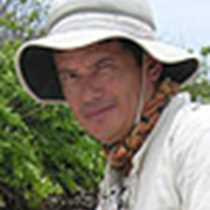Sombrero Chino and Santiago Islands
We started our day with a Zodiac cruise around Sombrero Chino. While observing from a distance the peculiar conical shape of this formation our guests understood the reason for its name in Spanish, roughly translated as “Chinese Hat” in English. Along the edges of the island we observed some migratory seashore birds. Many of them are mating at this time of the year making Galápagos their new temporary home; probably in the future these birds could be considered endemic to the archipelago if they stayed.
One of the most attractive places for snorkeling in Galápagos is the channel in front of Sombrero Chino, which is located a short distance from Santiago. This location is home of many species of tropical fish, sharks and marine iguanas. Santiago Island itself is like an open book of fascinating geology, a result of many volcanic eruptions that occurred along centuries that have helped to shape its appearance since then.
After the Zodiac ride, we went back to Sombrero Chino, and the underwater world that was waiting for us. It was so good that we wanted to stay there the whole day. We observed many colorful tropical fish, a great number of invertebrates such sponges, sea stars, sea cucumbers and many others living on the walls and on the bottom. It was as if they were competing with fish in loveliness and color; but the turquoise waters of Sombrero Chino were storing another surprise for us: marine iguanas feeding on algae underwater. It was amazing to observe these incredible creatures using their forelimbs to cling to the rocks and graze for more than eight minutes. A group of small damsel fish were seen biting the iguanas’ skin trying uselessly to frighten them away from their territories. The icing on the cake was the sighting of white tipped reef sharks swimming indifferently close to us; we observed their grey color contrasting with the bluish ocean. The latter conditions were great for photography.
In the afternoon we headed to Santiago Island to visit one of the most famous volcanic places in the archipelago, Sullivan Bay. At this location it is possible to observe how ancient islets suddenly disappeared or were surrounded by new black lava flows. Just as if a part of Santiago was reclaiming more and more territory. It was easy for us to imagine what Galápagos was like millions of years ago and when the adverse conditions were inhospitable for life and the first iguanas were able to survive here.
At some point along our walk we had a chance to stop and feel the cooling breeze and observe on that young lava a group of pioneering bushes growing up and preparing the terrain for future new arrivals. When we arrived to the old lava fields, the color changed completely from brownish to reddish, giving the sensation that we were in another world.
It was late and dark when we returned to the ship. From the Zodiacs we observed as the island disappeared leaving behind good memories of another day in this paradise called Galápagos.




